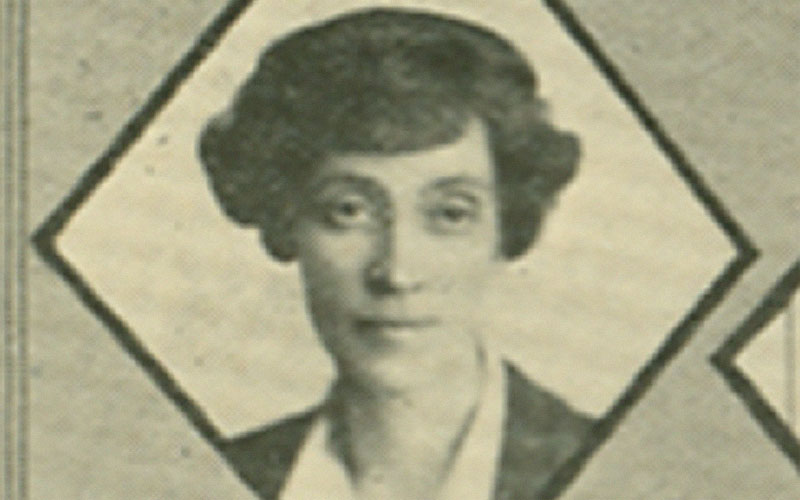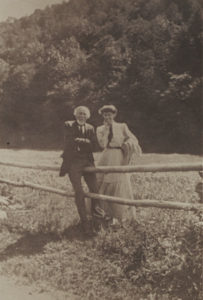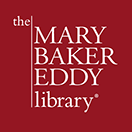Women of History: Mary Burt Messer

Photo of Mary Burt Messer from Stout Institute’s The Tower yearbook, 1922.
Unknown photographer. Internet Archive.
Mary Burt Messer (1881–1960) was an American sociologist, author, feminist, and Christian Scientist. Her story is almost forgotten, and currently there’s no mention of her on Wikipedia. An internet search lists titles of several books she wrote but turns up little about her as the author.
Consulting the directory of The Christian Science Journal, we find Messer listed as a public practitioner of Christian Science healing from 1931 to 1960. In Health and Medicine in the Christian Science Tradition, author and historian Robert Peel quotes Messer’s 1928 book The Family in the Making; that brought her to the Library’s attention and initiated our search of The Mary Baker Eddy Library’s archives to learn more about her.1 2
She was born in Washington, D.C., to Emma North Bacon (1852–1938) and Edmund Clarence Messer (1842–1919), the older of their two daughters. Her sister, Margaret, died as a child. Her father was a well-known artist and the principal of the Corcoran School of Art in Washington from 1902 to 1918.34
While it is difficult to piece together a chronology of Messer’s earlier career, her suffrage activities may have begun while she was a student at Vassar College.5 After that she became a social worker in New York City6 and was an organizer for the New York State Suffrage Association, under Carrie Chapman Catt. She was also a member of the National Woman’s Party.7 By the time American women gained the elective franchise in 1920, Messer was teaching at Stout Institute in Menomonie, Wisconsin, the forerunner of the University of Wisconsin–Stout. She was a professor of sociology at Stout and “devoted particular attention, in teaching her courses, to the question of the status of women.”8

Mary Burt Holt Messer standing outdoors with her father Clare Messer, who is sitting on a rail fence, c. 1895–1905. A148-79-7. Unknown photographer. Courtesy Schlesinger Library, Radcliffe Institute, Harvard University.
Messer’s study of Christian Science led her to join The Mother Church (The First Church of Christ, Scientist) in 1917, when in her mid-30s. A few years later she took Primary class instruction—a 12-day course in the religion—from Frank Walter Gale, CSD, of San Francisco.9
In 1928 Messer made a contribution to the emerging discipline of sociology, with the publication of her best-known book, The Family in the Making: An Historic Sketch.10 It dealt with the changing role of women in society over time and its impact on the family. In the chapter “The Advance of Woman,” Messer touched sympathetically on the influence of Christian Science in society (see pages 352–355). She wrote, in part:
[T]he movement of Christian Science stands forth as a conception of the Christian religion drawn from woman’s insight, quietly advancing woman to a position of equality with man in the Christian church, and conceiving the spiritual or creative principle in feminine as well as in masculine terms….
As contrasted with other movements making for woman’s political, educational and professional advancement, this movement (free of these specific aims) proceeds without a gesture of discrimination between the case of woman and that of all humankind…. Continually dependent on its striking “works,” its enterprise has been the direct expression of an active principle, the discovery of its leader, Mary Baker Eddy, whose Science and Health with Key to the Scriptures, however baffling to scholars, has commanded the attention of an enormous…public for over half a century. An international newspaper bearing the name of the movement and founded by its leader is valued by enlightened readers throughout the world….
As to the social significance of this new movement carrying forward an intuitive value, especially as touching family problems, it may be said that this is to be read at the present hour rather in general aspects…. [A] movement involving such new attitudes and devoted so largely to the elemental work of healing requires in the nature of the case more than half a century to realize its own implications….11
By 1922 or 1923, Messer had relocated to California with her mother and was teaching courses for credit at the University of California Extension in Berkeley, where they lived. Not long after, she shifted her focus to Christian Science healing and became listed as a Christian Science practitioner. She spent the last three decades of her life in that public healing work—but also continued her involvement in issues related to the status of women, especially in international relations.
Sometimes it was difficult for Messer to balance those commitments. Practitioners are required to give their full time to the work of healing through prayer; they earn their living from fees paid by patients, and not from a church salary. Messer’s unusual background at times complicated her situation. In 1945 she represented the National Woman’s Party as a consultant at the San Francisco Conference, which organized the United Nations. She played a similar role at the 1946 UN Assembly, where she “aided in the effort which resulted in the adoption of the Assembly resolution calling on all member nations to give equal rights to women.” She then participated in the inaugural meeting of the UN Commission on the Status of Women in 1947.12
Messer saw herself as a writer “experienced in research and investigation,”13 and she contributed many articles and poems to The Christian Science Monitor. She also published several pieces in the church’s religious magazines over the years.14 There is evidence that she hoped to obtain a full-time position as a Monitor staff writer, after proposing and writing the first of what she envisioned as an extensive series of articles for the newspaper. But that did not happen. Her Monitor articles sometimes contained more explicit references to Christian Science than was usual in that publication, and while this delighted some readers, it was not the tenor the editors promoted. Her pieces point to her fundamental interest—investigating social problems of all kinds in the light of Christian Science. She also may have looked to no avail for work in the editorial department of the religious magazines.15
Messer wrote two more books later in life—East and West (1950) and The Science of Society (1959).16 Periods of intensive writing limited her availability as a practitioner and initiated discussions about the temporary removal of her listing in the Journal, although this never occurred.
Her interest in world affairs and involvement with the United Nations, along with her Christian commitment, made Messer a fervent anti-Marxist. East and West (really a 63-page pamphlet) contrasted the dialectical materialism of Marx with what the book’s jacket called Eddy’s “spiritually realized Science”—a difficult task. The Monterey Peninsula Herald published a non-committal review, acknowledging the author as “a well known resident” of Carmel, California (where by that time she had lived for about 20 years after leaving Berkeley).17 A review in the Monitor acknowledged that the book’s theme was “a tremendous one” but also observed that it was “suggested but not developed.” The reviewer commented that “in the great ideological struggle between East and West, the most profoundly disturbing element is the degree to which western thought is permeated by the very materialism it condemns in communism.”18
Messer’s desire to evaluate systems and trends in the light of Christian Science was indeed ambitious. And it may have been out of consideration for her that the Monitor prepared—but did not publish—a review of The Science of Society in 1959. She had hoped The Christian Science Publishing Society would issue this book.19 The review stated, in part:
The cryptic subtitle of this book—“The Identity of Each as Godlike Embracing All”—indicates something of the difficulty it poses for the average reader. This is neither sociology nor religion as he is accustomed to think of them…. Thirty years ago, in a book entitled “The Family in the Making,” Miss Messer expressed her conviction that Christian Science has a revolutionary contribution to make to society as well as to the individual, and the present work undertakes to spell this out.
Not all who share the author’s conviction will be able to follow her exposition of it….20
Messer lived the last few years of her life in Cambridge, Massachusetts. Perhaps she did not always achieve her cherished goals in forging new ties between the worlds of sociology and Christian Science. But her scholarship, social conscience, activism, and spiritual commitment to practicing her faith for the public good make her a noteworthy contributor to the history of the Christian Science movement.
Listen to Women of History from the Mary Baker Eddy Library Archives, a Seekers and Scholars podcast episode featuring Library staffers Steve Graham and Dorothy Rivera.
- Robert Peel, Health and Medicine in the Christian Science Tradition (New York: Crossroad, 1988), 42–43.
- Robert Peel was a leading twentieth-century scholar of Eddy and Christian Science. His three-volume biographical trilogy—Mary Baker Eddy: Years of Discovery, Mary Baker Eddy: Years of Trial, and Mary Baker Eddy Years of Authority—stands as foundational in the scholarship on her history.
- A Catalogue of the Collection of American Paintings in The Corcoran Gallery of Art (Washington, D.C.: Corcoran Gallery of Art, 1966), 145.
- Edmund C. Messer’s paintings are still featured by American art auction houses; Bedford Gallery includes a brief biography.
- The Registrar of Vassar College stated, “According to our records, Mary Burt Messer was a ‘special student’ (non-matriculated) who attended for one year [1901–1902],” electronic mail communication, 15 September 2020.
- Irene Alexander, “Literary Guidepost,” Monterey Peninsula Herald, 26 January 1951.
- Data on Mary Burt Messer, n.d., Church Archives.
- Data on Mary Burt Messer, n.d., Church Archives.
- For more on Frank Walter Gale, see his reminiscence “Our Leader as Teacher and Friend” in We Knew Mary Baker Eddy, Expanded Edition, Volume I (Boston: The Christian Science Publishing Society, 2011), 212–220.
- Messer, The Family in the Making: An Historic Sketch (New York: G.P. Putnam’s Sons, 1928).
- Messer, The Family in the Making: An Historic Sketch (New York: G.P. Putnam’s Sons, 1928), 351–354.
- Data on Mary Burt Messer, n.d., Church Archives.
- Messer to the Christian Science Board of Directors, 16 November 1936, Church Archives.
- Messer published four articles between 1934 and 1943 in The Christian Science Journal and the Christian Science Sentinel; these contributions fell between the years of her greatest scholarly publication activities in the 1920s and 1950s.
- Memorandum, 16 November 1936, Church Archives.
- Messer, East and West, as face to face and side by side: A Christian Scientist replies to the Communist manifesto (New York: Philosophical Library, 1950); Messer, The Science of Society: the identity of each as Godlike, embracing all (New York: Philosophical Library, 1959).
- Irene Alexander, “Literary Guidepost,” Monterey Peninsula Herald, 26 January 1951.
- “Christian Science and Communism,” The Christian Science Monitor, 9 September 1950, Magazine section.
- Messer to the Board of Directors, 20 June 1958, Church Archives.
- Robert Peel to the Christian Science Board of Directors, 16 February 1959, Church Archives.

